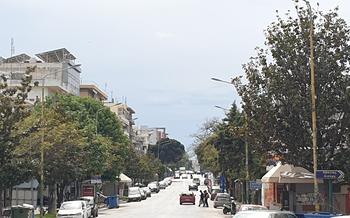
The Sanctuary of the Great Gods on Samothraki
- The Sanctuary of the Great Gods
- Location and Accessibility
- Ancient Rituals and Mysteries
- The Anaktoron
- The Arsinoeion
- The Hieron
- The Temenos
- The Theater
- The Museum of Samothrace: A Treasure Trove of Ancient Discoveries
- Natural Beauty of Samothraki
- Local Culture and Cuisine
- Accommodation and Amenities
- Sustainable Tourism
- Insider Tip: Unveiling the Enchanting Secrets of the Sanctuary
The Sanctuary of the Great Gods
The Sanctuary of the Great Gods on Samothraki is an ancient religious site of immense significance, shrouded in mystery and steeped in legend. Dedicated to the enigmatic deities known as the Kabeiroi, the sanctuary was a prominent center of worship and pilgrimage in the ancient world. Its origins can be traced back to the 6th century BC, and it flourished for over a millennium, attracting devotees from across the Mediterranean region.
Archaeological excavations conducted at the sanctuary have revealed a wealth of artifacts, including impressive statues, intricate inscriptions, and opulent offerings, providing valuable insights into the religious practices and rituals performed at this sacred site. Myths and legends associated with the sanctuary add to its allure, weaving tales of divine presence, miraculous healings, and secret initiations into the mysteries of the Kabeiroi.
The sanctuary's unique architectural features, including its processional path, temples, and sacred precinct, reflect the profound reverence accorded to the Great Gods. Its enduring legacy continues to captivate visitors, inviting them to explore the depths of ancient spirituality and immerse themselves in the timeless aura of this extraordinary sanctuary.
Location and Accessibility
Samothraki, an enchanting island nestled in the northern Aegean Sea, boasts a rich history and natural beauty. To reach this idyllic destination, travelers can embark on a scenic ferry journey from the mainland port of Kavala. Several ferry companies operate regular routes, offering a comfortable and convenient mode of transport. The crossing typically takes around 2 hours and 30 minutes, providing ample time to relax and admire the breathtaking views of the coastline.
Upon arrival at Samothraki, visitors are greeted by a picturesque harbor town called Kamariotissa. From here, the journey to the Sanctuary of the Great Gods continues by road. The sanctuary is situated approximately 10 kilometers from Kamariotissa, easily accessible by car or taxi. The drive takes around 20 minutes, winding through lush landscapes and offering glimpses of the island's verdant interior.
Samothraki's proximity to other popular destinations in Greece makes it an ideal stop on a broader itinerary. From the island, travelers can conveniently explore neighboring regions such as Thrace, Macedonia, and Halkidiki. This allows for a diverse and enriching travel experience, combining ancient history, stunning natural scenery, and vibrant local cultures.
When planning a visit to the Sanctuary of the Great Gods, it is advisable to consider the time of year. The summer months (June to August) offer warm and sunny weather, perfect for outdoor exploration and beach activities. However, during this peak season, the island tends to be more crowded with tourists. For those seeking a quieter experience, spring (April-May) and autumn (September-October) offer pleasant temperatures and fewer crowds, making it an ideal time to immerse oneself in the tranquility and spirituality of the sanctuary.
Ancient Rituals and Mysteries
The Sanctuary of the Great Gods was not just a place of worship; it was also a site of ancient rituals and mysteries. The Kabeiroi, the enigmatic deities worshipped at the sanctuary, were associated with fertility, the underworld, and the mysteries of life and death. Initiates to the cult of the Kabeiroi underwent sacred ceremonies and rituals, including purification rites, processions, and sacrifices. These rituals were believed to bestow divine blessings, protection, and secret knowledge upon the participants. Archaeological evidence unearthed at the sanctuary, such as votive offerings and inscriptions, provides tantalizing clues about the nature of these ancient practices, offering a glimpse into the spiritual beliefs and rituals of the ancient Greeks.
The Anaktoron
At the heart of the Sanctuary of the Great Gods stands the imposing Anaktoron, the main temple structure that served as the focal point of religious ceremonies and rituals. Constructed in the 4th century BC, the Anaktoron showcases impressive dimensions, measuring approximately 38 meters in length and 22 meters in width. Its grand entrance, adorned with Doric columns, leads visitors into a spacious interior that once housed a colossal statue of the Great Gods.
Archaeological excavations have unearthed a wealth of artifacts and offerings within the Anaktoron, providing valuable insights into the religious practices and beliefs of the ancient worshippers. Among the discoveries are marble statues, dedicatory inscriptions, and precious objects that shed light on the sacred nature of the sanctuary.
The Anaktoron's architectural features are a testament to the skill and artistry of the ancient builders. The temple's walls are constructed from massive blocks of stone, meticulously fitted together without the use of mortar. The interior is divided into three naves, separated by rows of columns that support the roof. The central nave, wider than the side aisles, leads to a raised platform where the statue of the Great Gods once stood.
The Anaktoron's significance extends beyond its architectural grandeur. It was the sacred space where the most important rituals and ceremonies took place, including the initiation rites of the Kabeiroi cult. The temple's imposing presence and elaborate decorations served to create an awe-inspiring atmosphere, enhancing the spiritual experience of the worshippers.
The Arsinoeion
The Arsinoeion, a circular building located within the Sanctuary of the Great Gods, holds a unique place in the archaeological landscape of Samothraki. Constructed in the 3rd century BC, this edifice was dedicated to the Ptolemaic queen Arsinoe II, wife of Ptolemy II Philadelphus. Its construction marked a significant period of patronage and influence by the Ptolemaic dynasty in the sanctuary.
The Arsinoeion showcases an exceptional architectural design, featuring a circular colonnade surrounding a central cella. The columns, originally adorned with intricate capitals, supported a conical roof, creating a striking silhouette against the backdrop of the sanctuary. The interior of the cella housed a statue of Arsinoe II, revered as a goddess and benefactor of the sanctuary.
Archaeological excavations have yielded valuable insights into the significance of the Arsinoeion. Numerous inscriptions and artifacts discovered within the building shed light on its religious function and the rituals associated with it. These findings suggest that the Arsinoeion served as a place of worship, dedications, and offerings to Arsinoe II, whose cult was closely intertwined with the broader mysteries and rituals of the sanctuary.
The Arsinoeion stands as a testament to the diverse influences and cultural exchanges that shaped the Sanctuary of the Great Gods. Its unique design and dedication to a foreign queen underscore the cosmopolitan nature of the sanctuary and its appeal to devotees from across the ancient world.
The Hieron
At the heart of the Sanctuary of the Great Gods lies the Hieron, a sacred precinct that served as the focal point of religious activities. Within the Hieron, visitors can explore the remains of several altars, temples, and other structures that once played a crucial role in the sanctuary's rituals and ceremonies.
One of the most prominent features of the Hieron is the Altar of the Great Gods, an impressive structure that stands as a testament to the sanctuary's significance. This altar was used for sacrifices and offerings to the deities worshipped at Samothraki, and its grand scale reflects the importance of these rituals in the ancient world.
Another notable structure within the Hieron is the Temple of the Kabeiroi, dedicated to the enigmatic deities themselves. This temple housed cult statues of the Kabeiroi, which were revered by initiates and pilgrims who sought spiritual guidance and enlightenment.
The Hieron also includes several other temples and altars dedicated to various deities and heroes associated with the sanctuary. These structures, along with the remains of stoas, porticoes, and other buildings, provide a glimpse into the diverse religious practices that took place within the sacred precinct.
By exploring the Hieron, visitors can gain a deeper understanding of the rituals and ceremonies that were central to the Sanctuary of the Great Gods. This sacred space was a place of profound spiritual significance, where initiates sought communion with the divine and endeavored to unlock the mysteries of the ancient world.
The Temenos
The Temenos, or sacred enclosure, surrounding the Sanctuary of the Great Gods played a crucial role in preserving the sanctity and exclusivity of the religious site. Constructed during the 4th century BC, the Temenos featured impressive fortifications and protective walls that demarcated the sacred space from the surrounding environment. Archaeological excavations have revealed substantial remains of these fortifications, providing insights into the defensive measures employed to safeguard the sanctuary.
Within the Temenos, evidence of settlements and various activities has been discovered, suggesting that the enclosure served multiple purposes beyond religious rituals. Residential areas, workshops, and storage facilities were likely present within the sacred precinct, indicating a vibrant community that supported and maintained the sanctuary. The Temenos served as a microcosm of the sanctuary's religious and secular life, fostering a sense of community and belonging among its inhabitants.
The Temenos also functioned as a protective barrier, shielding the sacred precinct from external influences and ensuring the privacy and security of religious ceremonies. The fortifications and walls acted as physical and symbolic boundaries, emphasizing the distinction between the sacred space and the profane world beyond. By restricting access and maintaining a controlled environment, the Temenos contributed to the preservation of the sanctuary's sanctity and the perpetuation of its religious traditions.
The Theater
Standing majestically amidst the sacred ruins of the Sanctuary of the Great Gods, the ancient theater of Samothraki is a testament to the vibrant cultural and religious life that once flourished on the island. Carved into the natural amphitheater of the hillside, the theater provided a breathtaking setting for performances, rituals, and events that brought together initiates and pilgrims from across the ancient world.
With a seating capacity of approximately 500 spectators, the theater's well-preserved stone tiers offer a unique vantage point from which to admire the sanctuary's sacred precinct and the stunning natural surroundings. The intricate acoustics, designed to amplify the voices of performers and the chanting of the initiates, create an immersive and awe-inspiring atmosphere that transports visitors back in time.
The theater's stage, adorned with intricate carvings and architectural details, served as a platform for a variety of performances, including theatrical productions, musical concerts, and ritual dances. These performances played a crucial role in the religious ceremonies and festivals held at the sanctuary, enhancing the spiritual and emotional experience of the participants.
Beyond its religious significance, the theater also served as a venue for cultural exchange and entertainment. Traveling performers and artists from across the Greek world would showcase their talents, sharing stories, music, and traditions that enriched the cultural landscape of Samothraki and contributed to the island's reputation as a center of learning and enlightenment.
Today, the theater stands as a silent witness to the vibrant past of the Sanctuary of the Great Gods. Visitors can wander among the ancient stone seats, imagining the sights and sounds that once filled this sacred space. The theater serves as a reminder of the enduring power of the arts and its ability to transcend time and connect us with the ancient world.
The Museum of Samothrace: A Treasure Trove of Ancient Discoveries
Located a short distance from the Sanctuary of the Great Gods, the Museum of Samothrace is a must-visit destination for anyone interested in the history and significance of the sanctuary. The museum houses a remarkable collection of artifacts unearthed during excavations at the sanctuary and from various locations on the island.
Among the highlights of the museum's exhibits are the famous Winged Victory of Samothrace, a breathtaking marble sculpture that once adorned the sanctuary's Nikephorion. Other notable artifacts include impressive statues of deities, intricate pottery, and inscriptions that shed light on the religious practices and rituals performed at the sanctuary.
The museum's well-curated displays provide visitors with a comprehensive understanding of the sanctuary's history, mythology, and cultural importance. Through these exhibits, visitors can gain insights into the lives and beliefs of the ancient Greeks and the significance of the Sanctuary of the Great Gods in the religious landscape of the ancient world.
Natural Beauty of Samothraki
Samothraki, the island that hosts the Sanctuary of the Great Gods, is not only a place of profound historical and religious significance but also a haven of natural wonders. The island's landscapes are a harmonious blend of lush forests, cascading waterfalls, and pristine beaches, offering visitors a chance to immerse themselves in the beauty of nature.
Venture into the island's verdant interior, and you'll be greeted by towering trees, fragrant wildflowers, and the soothing sounds of babbling brooks. The island's waterfalls, such as the stunning Fonias Waterfall, are natural masterpieces, where crystal-clear waters cascade down rocky cliffs, creating a mesmerizing spectacle.
Samothraki's coastline is equally captivating, with secluded coves, sandy beaches, and crystal-clear waters that beckon visitors to take a refreshing dip or indulge in water sports like swimming, snorkeling, and diving. The island's beaches, such as Pachia Ammos and Vatos, offer breathtaking views of the Aegean Sea and are ideal for sunbathing, relaxing, and enjoying the tranquility of the island's natural surroundings.
Whether you're an avid hiker, a nature enthusiast, or simply seeking a respite from the urban hustle, Samothraki's natural beauty offers something for everyone. Combine your visit to the Sanctuary of the Great Gods with outdoor activities like hiking, swimming, and exploring the island's hidden gems, and you'll create a truly unforgettable travel experience.
Local Culture and Cuisine
Samothraki is not just about ancient history and archaeological wonders; it also boasts a vibrant local culture and a distinct culinary identity that reflects the island's unique heritage. The Samothrace community is known for its warm hospitality, rich traditions, and a strong sense of community spirit. Visitors to the island have the chance to immerse themselves in the local way of life, interact with friendly locals, and experience authentic cultural expressions.
Traditional festivals and events are an integral part of Samothrace's cultural calendar, offering a glimpse into the island's rich heritage. The annual Panigiri of Agios Athanasios, held in August, is a highlight, attracting visitors from all over Greece. This vibrant festival celebrates the patron saint of the island with processions, traditional music, dancing, and local delicacies.
Samothrace's cuisine is a delightful blend of traditional Greek flavors and local ingredients. Freshly caught seafood, succulent meats, and homegrown vegetables form the basis of many dishes. Sample the island's specialties, such as the aromatic lamb kleftiko, slow-cooked in a wood-fired oven; the savory goat cheese, a local delicacy; or the sweet and crispy loukoumades, a traditional Greek dessert.
For a truly immersive experience, visitors can venture beyond the main tourist spots and explore the island's charming villages. There, they'll find traditional tavernas serving authentic local dishes, where they can mingle with locals, savor the flavors of Samothrace, and create lasting memories of their time on this enchanting island.
Accommodation and Amenities
Samothraki offers a range of accommodation options to suit every budget and preference. For a comfortable and convenient stay, consider booking a hotel or guesthouse near the Sanctuary of the Great Gods. These establishments provide easy access to the sanctuary and other attractions on the island.
For a more immersive experience, opt for traditional lodgings that offer a glimpse into the local culture. These charming accommodations often feature unique architectural styles and provide an authentic Samothrace experience.
When it comes to dining, there are plenty of restaurants, cafes, and tavernas scattered around the island. Indulge in delicious local cuisine, including fresh seafood, grilled meats, and traditional Greek dishes. Don't miss the opportunity to try Samothraki's famous goat cheese, a local delicacy.
To cater to your shopping needs, the island offers a variety of shops selling souvenirs, handicrafts, and local products. Support the local economy by purchasing unique items made by talented artisans.
Sustainable Tourism
Responsible tourism practices are crucial for preserving the integrity of the Sanctuary of the Great Gods and the natural beauty of Samothraki Island. Minimize your environmental impact by reducing waste, conserving water and energy, and respecting the local flora and fauna. Show respect for local customs and traditions by dressing appropriately, avoiding loud noises, and asking permission before taking photographs of people or sacred sites. Support local businesses and initiatives by purchasing souvenirs from local artisans, dining at traditional tavernas, and participating in cultural events. By embracing sustainable tourism, you contribute to the long-term preservation and sustainability of the sanctuary and the island, ensuring that future generations can experience its wonders.
Insider Tip: Unveiling the Enchanting Secrets of the Sanctuary
Venture beyond the main archaeological sites to discover hidden corners of the sanctuary that offer a glimpse into its mystical past. Explore the dense forest surrounding the ruins, where ancient pathways lead to secluded altars and enigmatic inscriptions. For photographers, the play of light and shadow at sunrise and sunset creates captivating opportunities to capture the essence of the sanctuary's grandeur. Plan your visit during the shoulder seasons (May-June or September-October) to avoid the summer crowds and immerse yourself in the tranquility of this sacred place, where the whispers of ancient rituals still linger in the air.









